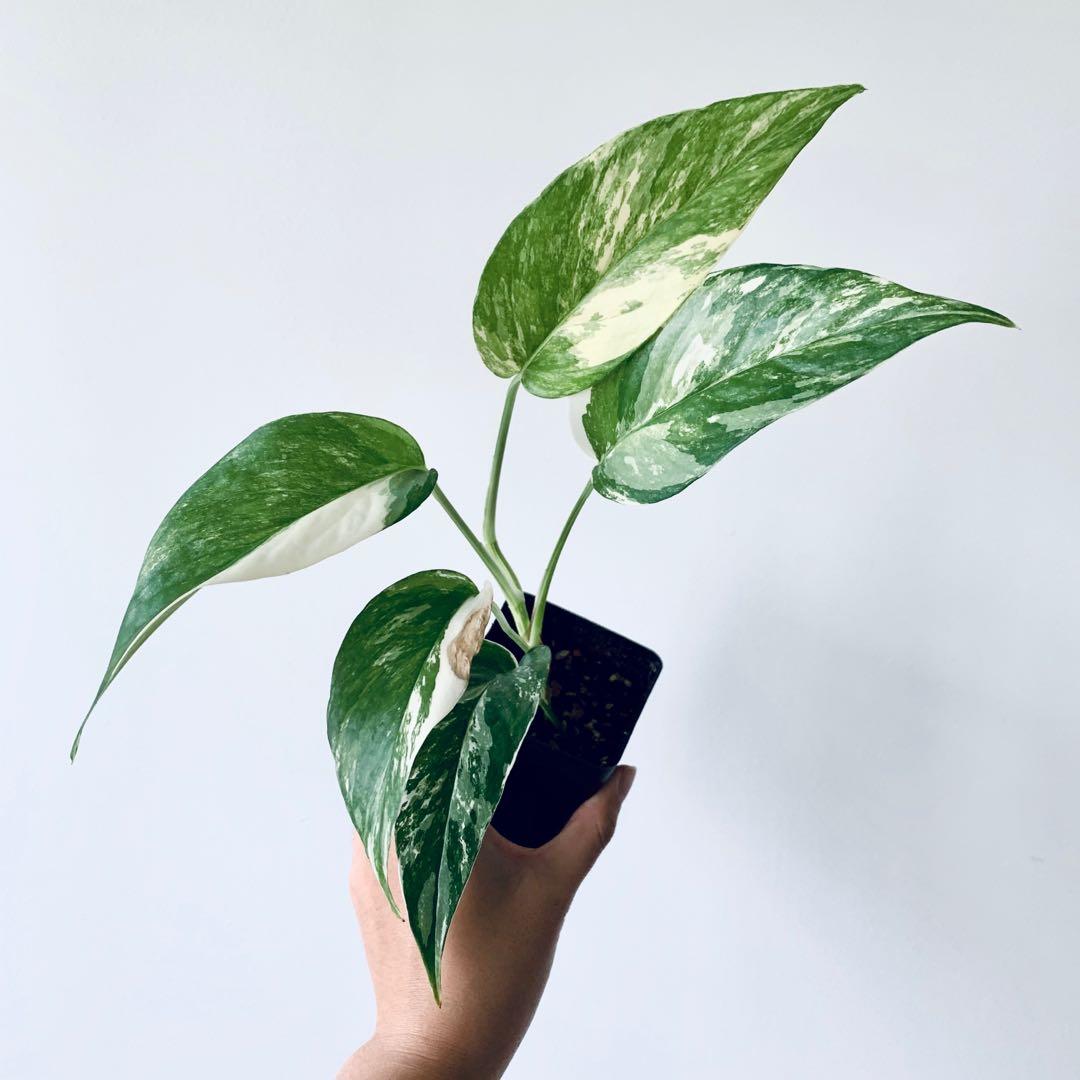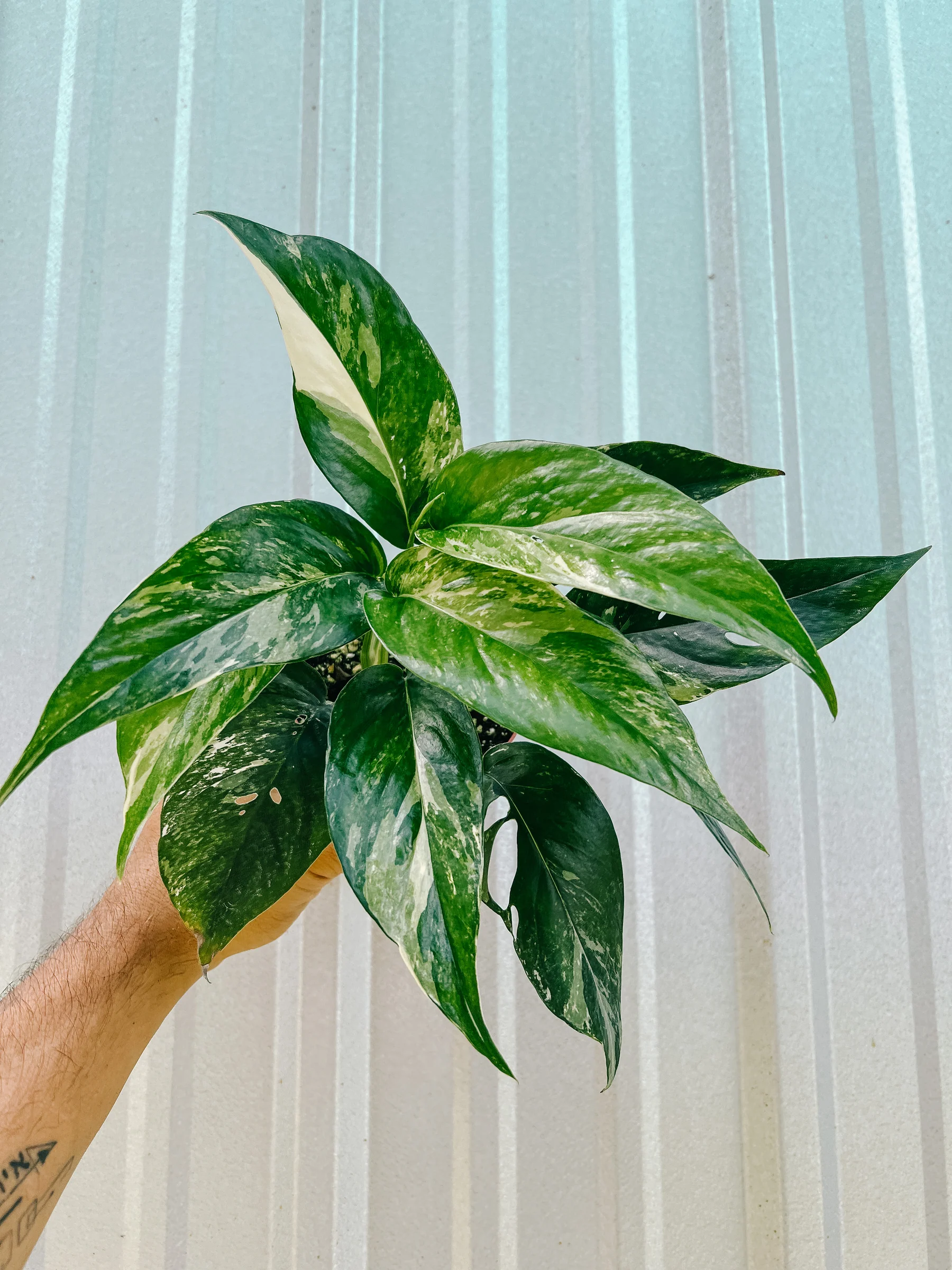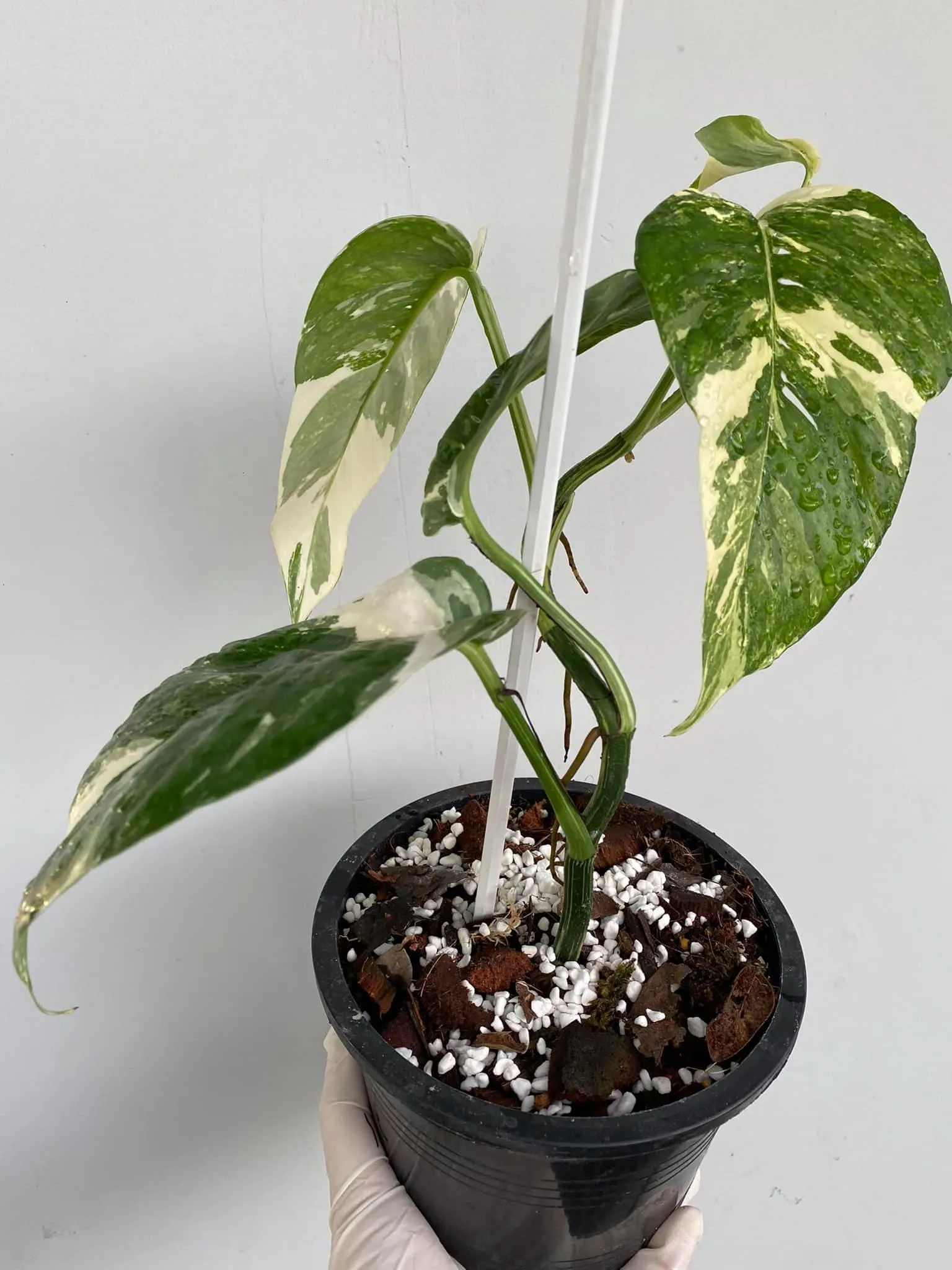Epipremnum Pinnatum Albo Variegated: A Comprehensive Guide
Epipremnum Pinnatum Albo is a gorgeous variegated form of the popular Houseplant Epipremnum Pinnatum, commonly known as Dragon Tail or Centipede Tongavine. With its striking white and green foliage, Epipremnum Pinnatum Albo makes an eye-catching addition to any indoor plant collection.

Epipremnum Pinnatum is native to Southeast Asia, including areas of Indonesia, China, India, and the Philippines. It's an evergreen vine that can grow quite large in its natural jungle habitat, climbing high up into the forest canopy.
Natural Features
In the wild, Epipremnum Pinnatum has entirely green leaves. The leaves are oval-shaped and pointy, emerging alternately along cascading stems that can reach lengths of several meters as the plant matures over time. Tiny white flowers may emerge under ideal conditions, but are rare on indoor plants.
Albo Variety
Epipremnum Pinnatum Albo is a cultivated variety of the species that has white variegation in its leaves. Each leaf is splashed with white coloration to varying degrees, creating a beautifully marbled effect. The variegation is stable, meaning it continues producing white and green leaves even with maturity and propagation.
To gain a broader understanding of Epipremnum varieties and their origins, delve into the "5 Stunning Epipremnum Varieties: A Must-See Guide!". This guide will expand your knowledge about the diverse and fascinating world of Epipremnum plants, highlighting their unique features and native environments.
Epipremnum Pinnatum Albo thrives as a houseplant when given the right care. Here's an overview of its key growing requirements:
Light
Bright, indirect light is ideal, such as near a south or west-facing window. Some direct sun is okay, but more than 2-3 hours can scorch the leaves. Low light causes leggy growth.
Water
Allow soil to mostly dry out between waterings. Water thoroughly until it drains from the pot's bottom hole, then wait until the top inch becomes dry before watering again. Too much moisture causes root rot.
Temperature & Humidity
Average home temperatures between 60-80°F suit it well. Higher humidity around 40-50% can help prevent pesky brown leaf tips from forming along the margins.
Soil
A well-draining potting mix provides the air circulation it needs around its roots. Amend regular potting soil with perlite or bark chips.
Fertilizer
Feed monthly during spring and summer with a balanced liquid fertilizer diluted to half strength. Cease fertilization over winter months.
For those interested in learning more about how to best nurture these plants, whether indoors or outdoors, I recommend exploring "5 Essential Tips for Thriving Epipremnum Indoors & Outdoors". This article provides essential care tips that are crucial for the healthy growth and maintenance of Epipremnum varieties.

"Discover the unique charm of the Epipremnum Pinnatum Albo - a must-have for plant enthusiasts! Click here to bring this stunning addition to your home today!"
Epipremnum Pinnatum Albo propagates easily for free plants! Here's an overview of propagation techniques:
Stem Cuttings
Snip off vine sections with at least 2 leaves, strip lower leaves, and place cuttings in water or moist potting mix. New roots form within a few weeks.
Air Layering
Make a small cut in an existing vine, wrap the area with sphagnum moss, and secure with plastic wrap to encourage aerial root growth for later detachment.
Top Cuttings
Cut off the tip of a vine section and place it upright in water or potting mix, keeping 2-3 leaves above the surface. New roots will emerge from the cut base.
With its trailing growth habit, Epipremnum Pinnatum Albo makes a gorgeous showpiece spilling from hanging baskets or mounted onto totem poles and trellises. Here are some ideas:
Hanging Baskets
A hanging basket with sphagnum moss lining allows the long vines to beautifully dangle down in their full glory. Situate near a bright window where the variegation will stand out.
Totem Poles & Trellises
Guide the wandering vines upward using bamboo sticks, small trellises, or moss or coco coir-wrapped poles. This neatly showcases the elongated oval leaves and gives the plant a tree-like form over time.
Mix With Other Plants
Combine in a large container with other popular trailing plants like Philodendrons, Pothos varieties, or trailing Scindapsus. The color contrast makes for vivd arrangements.

Epipremnum Pinnatum Albo is quite robust when given proper care, but may encounter a few issues:
Dropping Leaves
Overwatering and soggy soil causes leaf drop. Allow soil to dry out more between waterings. Underwatering can also cause leaves to yellow and fall.
Leggy Growth
Insufficient light leads to a long gap between leaves along the vines. Provide brighter light to encourage fuller growth.
Brown Leaf Tips
Low humidity and dry air cause brown crispy bits along the leaf margins. Mist frequently or use a pebble tray for added humidity.
With its show-stopping variegated foliage, Epipremnum Pinnatum Albo delivers outstanding ornamental value among houseplants. Cascades of white and green leaves create a stunning display and it propagates readily for endless free plants. When given bright, indirect light and proper care, this vining charmer will thrive indoors for years of enjoyment.
1. How often should I water my Epipremnum Pinnatum Albo Variegated? Watering should be done when the top inch of the soil feels dry. The frequency will depend on the environment but typically once a week is adequate.
2. Does the Epipremnum Pinnatum Albo Variegated need a lot of light? This plant prefers bright, indirect sunlight. However, it can tolerate lower light conditions, although growth may be slower and variegation less pronounced.
3. How do I propagate the Epipremnum Pinnatum Albo Variegated? Propagation is usually done through stem cuttings. Cut a stem with several nodes, place it in a pot with well-draining soil, and maintain a warm, humid environment.
4. Is the Epipremnum Pinnatum Albo Variegated toxic to pets? Yes, like many houseplants, it is toxic if ingested by pets. Therefore, it's best to keep it out of reach of your furry friends.
5. What should I do if my Epipremnum Pinnatum Albo Variegated's leaves are turning yellow? Yellow leaves could be a sign of overwatering or lack of nutrients. Check your watering routine and consider applying a balanced fertilizer.
https://bit.ly/3So5Z3g

Origins and Description
Epipremnum Pinnatum is native to Southeast Asia, including areas of Indonesia, China, India, and the Philippines. It's an evergreen vine that can grow quite large in its natural jungle habitat, climbing high up into the forest canopy.
Natural Features
In the wild, Epipremnum Pinnatum has entirely green leaves. The leaves are oval-shaped and pointy, emerging alternately along cascading stems that can reach lengths of several meters as the plant matures over time. Tiny white flowers may emerge under ideal conditions, but are rare on indoor plants.
Albo Variety
Epipremnum Pinnatum Albo is a cultivated variety of the species that has white variegation in its leaves. Each leaf is splashed with white coloration to varying degrees, creating a beautifully marbled effect. The variegation is stable, meaning it continues producing white and green leaves even with maturity and propagation.
To gain a broader understanding of Epipremnum varieties and their origins, delve into the "5 Stunning Epipremnum Varieties: A Must-See Guide!". This guide will expand your knowledge about the diverse and fascinating world of Epipremnum plants, highlighting their unique features and native environments.
Growing Conditions
Epipremnum Pinnatum Albo thrives as a houseplant when given the right care. Here's an overview of its key growing requirements:
Light
Bright, indirect light is ideal, such as near a south or west-facing window. Some direct sun is okay, but more than 2-3 hours can scorch the leaves. Low light causes leggy growth.
Water
Allow soil to mostly dry out between waterings. Water thoroughly until it drains from the pot's bottom hole, then wait until the top inch becomes dry before watering again. Too much moisture causes root rot.
Temperature & Humidity
Average home temperatures between 60-80°F suit it well. Higher humidity around 40-50% can help prevent pesky brown leaf tips from forming along the margins.
Soil
A well-draining potting mix provides the air circulation it needs around its roots. Amend regular potting soil with perlite or bark chips.
Fertilizer
Feed monthly during spring and summer with a balanced liquid fertilizer diluted to half strength. Cease fertilization over winter months.
For those interested in learning more about how to best nurture these plants, whether indoors or outdoors, I recommend exploring "5 Essential Tips for Thriving Epipremnum Indoors & Outdoors". This article provides essential care tips that are crucial for the healthy growth and maintenance of Epipremnum varieties.

"Discover the unique charm of the Epipremnum Pinnatum Albo - a must-have for plant enthusiasts! Click here to bring this stunning addition to your home today!"
Propagation
Epipremnum Pinnatum Albo propagates easily for free plants! Here's an overview of propagation techniques:
Stem Cuttings
Snip off vine sections with at least 2 leaves, strip lower leaves, and place cuttings in water or moist potting mix. New roots form within a few weeks.
Air Layering
Make a small cut in an existing vine, wrap the area with sphagnum moss, and secure with plastic wrap to encourage aerial root growth for later detachment.
Top Cuttings
Cut off the tip of a vine section and place it upright in water or potting mix, keeping 2-3 leaves above the surface. New roots will emerge from the cut base.
Potting Up & Arrangements
With its trailing growth habit, Epipremnum Pinnatum Albo makes a gorgeous showpiece spilling from hanging baskets or mounted onto totem poles and trellises. Here are some ideas:
Hanging Baskets
A hanging basket with sphagnum moss lining allows the long vines to beautifully dangle down in their full glory. Situate near a bright window where the variegation will stand out.
Totem Poles & Trellises
Guide the wandering vines upward using bamboo sticks, small trellises, or moss or coco coir-wrapped poles. This neatly showcases the elongated oval leaves and gives the plant a tree-like form over time.
Mix With Other Plants
Combine in a large container with other popular trailing plants like Philodendrons, Pothos varieties, or trailing Scindapsus. The color contrast makes for vivd arrangements.

Common Concerns
Epipremnum Pinnatum Albo is quite robust when given proper care, but may encounter a few issues:
Dropping Leaves
Overwatering and soggy soil causes leaf drop. Allow soil to dry out more between waterings. Underwatering can also cause leaves to yellow and fall.
Leggy Growth
Insufficient light leads to a long gap between leaves along the vines. Provide brighter light to encourage fuller growth.
Brown Leaf Tips
Low humidity and dry air cause brown crispy bits along the leaf margins. Mist frequently or use a pebble tray for added humidity.
Conclusion
With its show-stopping variegated foliage, Epipremnum Pinnatum Albo delivers outstanding ornamental value among houseplants. Cascades of white and green leaves create a stunning display and it propagates readily for endless free plants. When given bright, indirect light and proper care, this vining charmer will thrive indoors for years of enjoyment.
FAQs
1. How often should I water my Epipremnum Pinnatum Albo Variegated? Watering should be done when the top inch of the soil feels dry. The frequency will depend on the environment but typically once a week is adequate.
2. Does the Epipremnum Pinnatum Albo Variegated need a lot of light? This plant prefers bright, indirect sunlight. However, it can tolerate lower light conditions, although growth may be slower and variegation less pronounced.
3. How do I propagate the Epipremnum Pinnatum Albo Variegated? Propagation is usually done through stem cuttings. Cut a stem with several nodes, place it in a pot with well-draining soil, and maintain a warm, humid environment.
4. Is the Epipremnum Pinnatum Albo Variegated toxic to pets? Yes, like many houseplants, it is toxic if ingested by pets. Therefore, it's best to keep it out of reach of your furry friends.
5. What should I do if my Epipremnum Pinnatum Albo Variegated's leaves are turning yellow? Yellow leaves could be a sign of overwatering or lack of nutrients. Check your watering routine and consider applying a balanced fertilizer.
https://bit.ly/3So5Z3g
Nhận xét
Đăng nhận xét